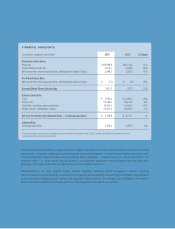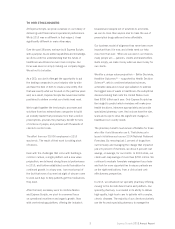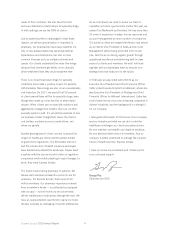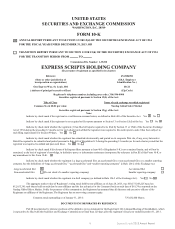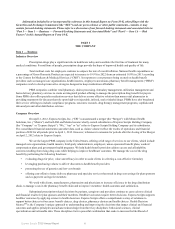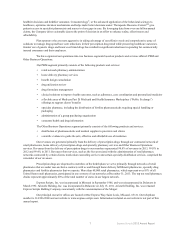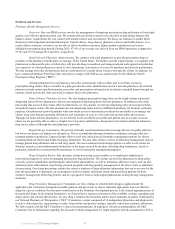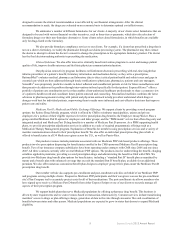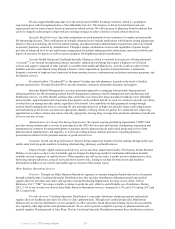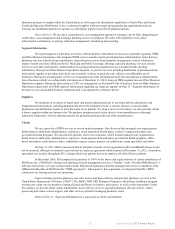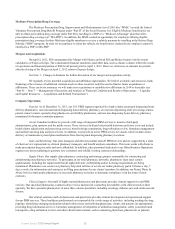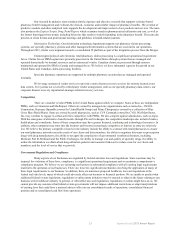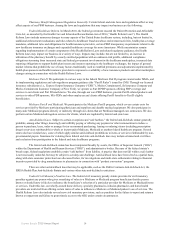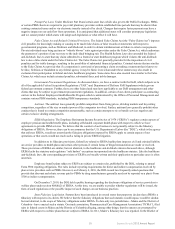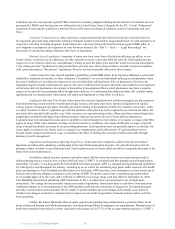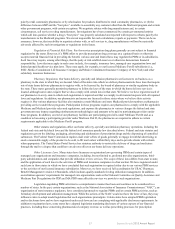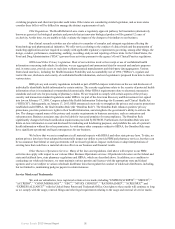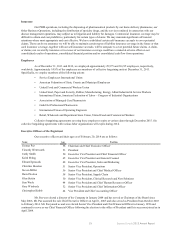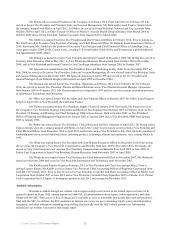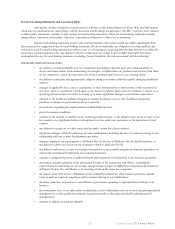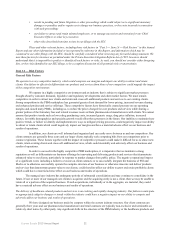Express Scripts 2013 Annual Report Download - page 12
Download and view the complete annual report
Please find page 12 of the 2013 Express Scripts annual report below. You can navigate through the pages in the report by either clicking on the pages listed below, or by using the keyword search tool below to find specific information within the annual report.
Express Scripts 2013 Annual Report 12
Medicare Prescription Drug Coverage
The Medicare Prescription Drug, Improvement and Modernization Act of 2003 (the “MMA”) created the federal
Voluntary Prescription Drug Benefit Program under “Part D” of the Social Security Act. Eligible Medicare beneficiaries are
able to obtain prescription drug coverage under Part D by enrolling in a PDP or a “Medicare Advantage” plan that offers
prescription drug coverage (an “MA-PDP”). In addition, the MMA created an opportunity for employers offering eligible
prescription drug coverage for their Medicare-eligible members to receive a subsidy payment by enrolling in the Retiree Drug
Subsidy (“RDS”) program. In order for an employer to claim the subsidy, the beneficiaries claimed by the employer cannot be
enrolled in a PDP or MA-PDP.
Mergers and Acquisitions
On April 2, 2012, ESI consummated the Merger with Medco and both ESI and Medco became wholly-owned
subsidiaries of Express Scripts. The consolidated financial statements (and other data, such as claims volume) reflect the results
of operations and financial position of ESI for all periods prior to April 1, 2012. However, references to amounts for periods
after the closing of the Merger on April 2, 2012 relate to Express Scripts.
See Note 3 - Changes in business for further discussion of our merger and acquisition activity.
We regularly review potential acquisitions and affiliation opportunities. We believe available cash resources, bank
financing or the issuance of additional common stock or other securities could be used to finance future acquisitions or
affiliations. There can be no assurance we will make new acquisitions or establish new affiliations in 2014 or thereafter (see
“Part II — Item 7 — Management’s Discussion and Analysis of Financial Condition and Results of Operations — Liquidity
and Capital Resources — Acquisitions and Related Transactions”).
Company Operations
General. As of December 31, 2013, our U.S. PBM segment operated five high-volume automated dispensing home
delivery pharmacies, one non-automated dispensing home delivery pharmacy, several non-dispensing order processing centers,
patient contact centers, specialty drug pharmacies and fertility pharmacies, and one non-dispensing home delivery pharmacy
maintained for business continuity purposes.
At our Canadian facilities we provide a full range of integrated PBM services to insurers, third-party
administrators, plan sponsors and the public sector. These services facilitate better health decisions and lower costs and include
health claims adjudication and processing services, benefit-design consultation, drug-utilization review, formulary management
and medical and drug data analysis services. In addition, we provide an active PBM service in Canada, which includes home
delivery of maintenance prescription medications from four regional dispensing pharmacy locations.
Sales and Marketing. Our sales managers and directors market and sell PBM services and are supported by a team
of client service representatives, clinical pharmacy managers, and benefit analysis consultants. This team works with clients to
make prescription drug use safer and more affordable. In addition, sales personnel dedicated to our Other Business Operations
segment use direct marketing to generate new customers and solidify existing customer relationships.
Supply Chain. Our supply chain pharmacy contracting and strategy group is responsible for contracting and
administering our pharmacy networks. To participate in our retail pharmacy networks, pharmacies must meet certain
qualifications, including the requirement that all applicable state credentialing and/or licensing requirements are being
maintained. Pharmacies can contact our pharmacy help desk toll free or access our online pharmacy portal 24 hours a day, 7
days a week, for information and assistance in filling prescriptions for our clients’ members. In addition, our Fraud, Waste &
Abuse Services team audits pharmacies in our retail pharmacy networks to determine compliance with the terms of their
contracts.
Clinical Support. Our staff of highly trained pharmacists and physicians provides clinical support for our PBM
services. Our specialist pharmacists conduct safety reviews and provide counseling for members with clinical needs in their
specialty. We have specialist pharmacists in more than a dozen specialties, including oncology, diabetes care and cardiovascular
disease.
Our clinical solutions staff of pharmacists and physicians provides clinical development and operational support
for our PBM services. These healthcare professionals are responsible for a wide range of activities, including tracking the drug
pipeline; identifying emerging medication-related safety issues and notifying physicians, clients, and patients (as appropriate);
providing drug information services; formulary management; development of utilization management, safety (concurrent and
retrospective drug utilization review) and other clinical interventions; and/or contacting physicians, pharmacists or patients.


